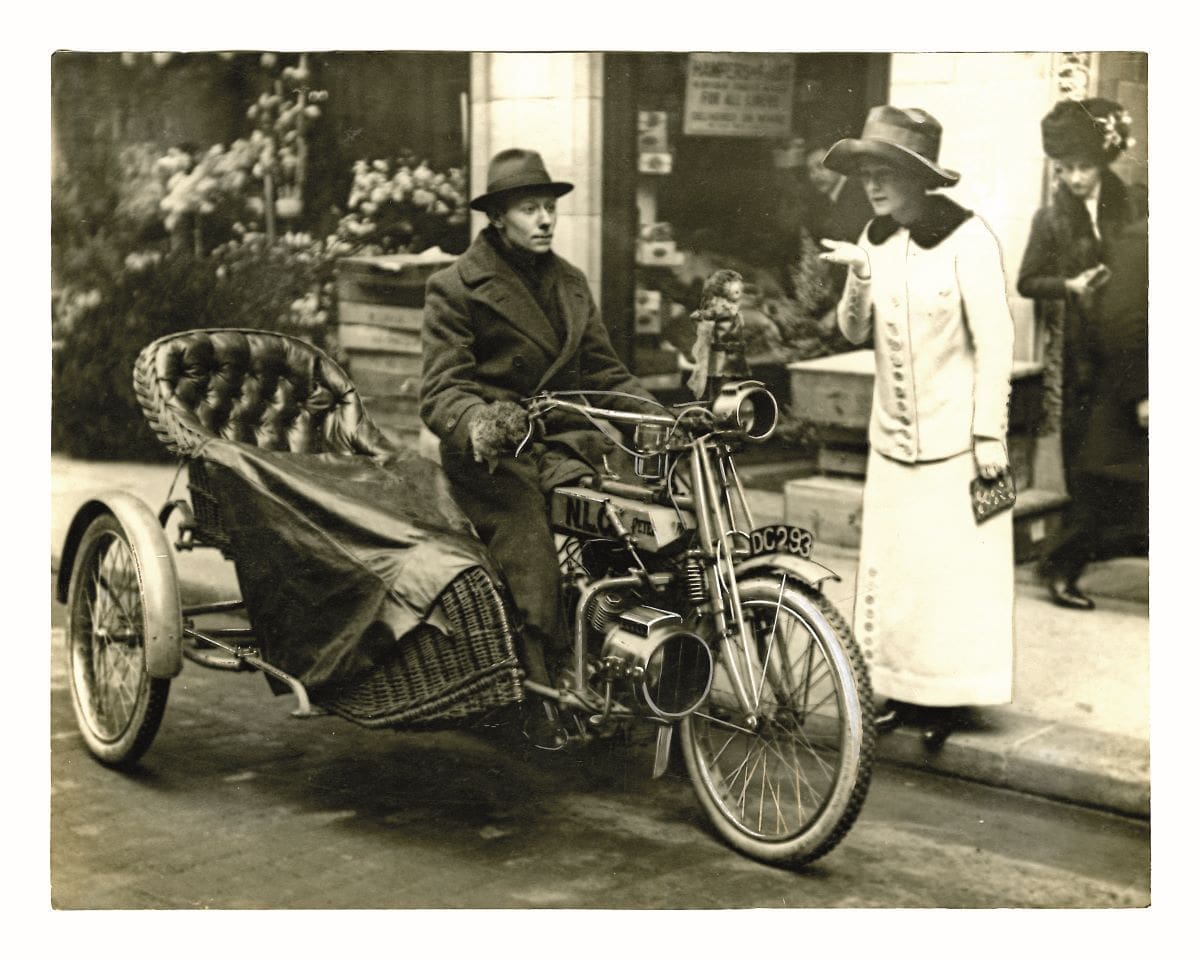Mysterious picture of a motorcycle with right-hand attached sidecar in 1911 London, being blown a kiss by a stage star…

Photograph: Mortons Archive
This photograph at a glance seems perhaps innocuous enough, but closer inspection turns up a few anomalies – the most obvious being, why has the motorcycle – which bears the British registration plate DC293, with DC a Chester-issued number – got its sidecar mounted on the right side, thrusting the passenger face-first into oncoming traffic. The second question is – what is it?
Again, on first inspection it seems to have NLG on the fuel tank, thus answering that one. But on blowing up the picture, it also has Peter Pan on it – which clears things up a little. For the caption which accompanied it in the January 4, 1912, number of The Motor Cycle read: “Miss Pauline Chase christening a new motor bicycle before proceeding to the Duke of York’s Theatre to resume her part of Peter Pan. Miss Chase has played the role nearly a thousand times.”
That gives a few more things to consider – the fact the caption states the motorcycle is ‘new’ must come from somewhere and it certainly looks to be modern by 1911/12 standards, while NLG would make sense as the maker.
NLG stood for North London Garage, with the 1908 founded maker having the honour of being, with Will Cook in the saddle, winner of the first motorcycle race at Brooklands. Cook went on to campaign the gargantuan 2700cc JAP-powered V-twin, of which Czech Pavel Malanik built a replica and which was seen at events, including the Montlhery Vintage Revival.
NLG – based in Highbury, Corsica Street, St Paul’s Road – was a short-lived maker though it did list models such as that which appears to be shown, with either Peugeot (as powered Cook’s first Brooklands win racer) or local firm JAP (as in the 2.7 litre behemoth) the engine suppliers. It could very well be that it is an NLG, though the script on the tank does have something of the hand-painted look to it. And it does look to say ‘Peter Pan’, suggesting some kind of publicity link to the production, perhaps?
J M Barrie’s Peter Pan (also known as The Boy Who Wouldn’t Grow Up) had debuted at the Duke of York’s Theatre in December 1904, becoming a huge success. Chase (born in Washington DC and who travelled to England at 15 to star on the stage), was in the cast (one of the Lost Boys) for the first staging ,and performed other roles too, before getting her big chance when the star turn became ill, allowing Chase, as understudy, to step in.
Barrie was so impressed with Chase’s turn that the role became hers – she returned as Peter Pan every year until 1913, when, aged 28 and a reputed 1400 depictions, she retired from the stage to marry. Chase was a committed Anglophile, who remained in the UK all of her life; she was baptised in the Church of England in 1906, with J M Barrie her godfather. Her only film appearance was when she came out of retirement to appear in The Real Thing at Last, a satirical film written by Barrie for the benefit of the YMCA. Famously, Barrie gifted the copywrite of Peter Pan to Great Ormond Street Hospital, London.
But who is the man on the motorcycle, which may or may not be an NLG, but which undoubtedly has ‘Peter Pan’ written on its petrol tank? It may well be Charles Frohman, an American theatre manager and producer, who was a great friend of Ms Chase’s. Perhaps, as an American, he had bought the combination – which sports an additional, huge carriage-type lamp – with the intention of taking it back to his home country? Born in Ohio, in 1856, Frohman controlled five theatres in the UK and was a frequent visitor to London. He was aboard the Lusitania in May 1915 when the ship was struck by a torpedo from a German U-boat. Apparently, after tying lifejackets to the Moses baskets containing babies which had been asleep in the nursery at the time the torpedo struck, Frohman clasped hands with his various friends including the actress (and Frohman protégé) Rita Jolivet, and quoted the words from Peter Pan; “Why fear death? It is the most beautiful adventure life gives us.” Jolivet survived; Frohman and 1197 others (including the other three friends with whom he had joined hands) perished in the sea, seven miles off Cork. Frohman’s body was returned to America and he was buried in New York.
There is a Charles Frohman Monument in the Buckinghamshire town of Marlow,a place with which he formed a greatbond. Created by sculptor Leonard Merrifield and unveiled in 1924, itfeatures a nude woman, who iswidely speculated to be Pauline Chase, Frohman’s great friend and another fan of Marlow.
Ms Chase, who had three children with her husband, died in Tunbridge Wells in 1962.



